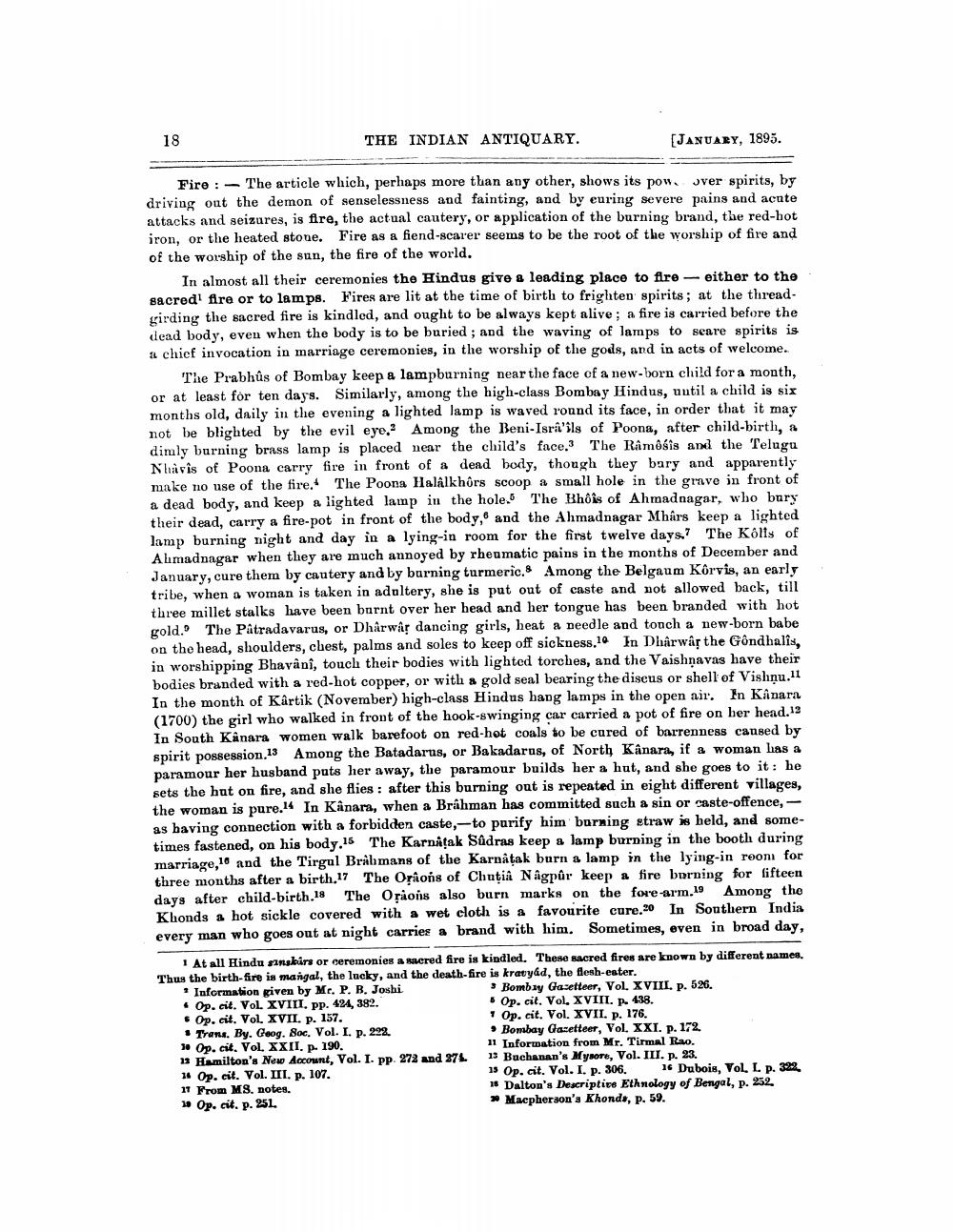________________
18
THE INDIAN ANTIQUARY.
Fire: The article which, perhaps more than any other, shows its pow. over spirits, by driving out the demon of senselessness and fainting, and by euring severe pains and acute attacks and seizures, is fire, the actual cautery, or application of the burning brand, the red-hot iron, or the heated stone. Fire as a fiend-scarer seems to be the root of the worship of fire and of the worship of the sun, the fire of the world.
[JANUARY, 1895.
In almost all their ceremonies the Hindus give a leading place to fire either to the sacred fire or to lamps. Fires are lit at the time of birth to frighten spirits; at the threadgirding the sacred fire is kindled, and ought to be always kept alive; a fire is carried before the dead body, even when the body is to be buried; and the waving of lamps to scare spirits is a chief invocation in marriage ceremonies, in the worship of the gods, and in acts of welcome.
The Prabhûs of Bombay keep a lampburning near the face of a new-born child for a month, or at least for ten days. Similarly, among the high-class Bombay Hindus, until a child is six months old, daily in the evening a lighted lamp is waved round its face, in order that it may not be blighted by the evil eye. Among the Beni-Isra'ils of Poona, after child-birth, a dimly burning brass lamp is placed near the child's face.3 The Râmêsîs and the Telugu Nhavis of Poona carry fire in front of a dead body, though they bary and apparently make no use of the fire. The Poona Halâlkhôrs scoop a small hole in the grave in front of a dead body, and keep a lighted lamp in the hole. The Bhôis of Ahmadnagar, who bury their dead, carry a fire-pot in front of the body, and the Ahmadnagar Mhârs keep a lighted lamp burning night and day in a lying-in room for the first twelve days. The Kôlls of Ahmadnagar when they are much annoyed by rheumatic pains in the months of December and January, cure them by cautery and by burning turmeric. Among the Belgaum Kôrvis, an early tribe, when a woman is taken in adultery, she is put out of caste and not allowed back, till three millet stalks have been burnt over her head and her tongue has been branded with hot gold. The Pâtradavarus, or Dharwâr dancing girls, heat a needle and tonch a new-born babe on the head, shoulders, chest, palms and soles to keep off sickness,10 In Dharwâr the Gôndhalis, in worshipping Bhavânî, touch their bodies with lighted torches, and the Vaishnavas have their bodies branded with a red-hot copper, or with a gold seal bearing the discus or shell of Vishnu.11 In the month of Kârtik (November) high-class Hindus hang lamps in the open air. In Kânara (1700) the girl who walked in front of the hook-swinging car carried a pot of fire on her head.12 In South Kanara women walk barefoot on red-hot coals to be cured of barrenness caused by spirit possession.13 Among the Batadarus, or Bakadarus, of North Kânara, if a woman has a paramour her husband puts her away, the paramour builds her a hut, and she goes to it: he sets the hut on fire, and she flies: after this burning out is repeated in eight different villages, the woman is pure.14 In Kânara, when a Brahman has committed such a sin or caste-offence,as having connection with a forbidden caste,-to purify him burning straw is held, and sometimes fastened, on his body.15 The Karnatak Sûdras keep a lamp burning in the booth during marriage, and the Tirgul Brahmans of the Karnatak burn a lamp in the lying-in room for three months after a birth.17 The Orions of Chutia Nagpûr keep a fire burning for fifteen days after child-birth.18 The Oraons also burn marks on the fore-arm.19 Among the Khonds a hot sickle covered with a wet cloth is a favourite cure.20 In Southern India. every man who goes out at night carries a brand with him. Sometimes, even in broad day,
16
1 At all Hindu sinskårs or ceremonies a sacred fire is kindled. These sacred fires are known by different names. Thus the birth-fire is mangal, the lucky, and the death-fire is kravyád, the flesh-eater.
3 Bombay Gazetteer, Vol. XVIII. p. 526.
* Information given by Mr. P. B. Joshi Op. cit. Vol. XVIII. pp. 424, 382.
Op. cit. Vol. XVII. p. 157.
Trans, By. Geog. Soc. Vol. I. p. 222.
30 Op. cit. Vol. XXII. p. 190.
13 Hamilton's New Account, Vol. I. pp. 272 and 274.
14 Op. cit. Vol. III. p. 107.
17 From MS. notes.
10 Op. cit. p. 251.
Op. cit. Vol. XVIII. p. 438.
1 Op. cit. Vol. XVII. p. 176.
Bombay Gazetteer, Vol. XXI. p. 172.
11 Information from Mr. Tirmal Rao.
13 Buchanan's Mysore, Vol. III. p. 23.
15 Op. cit. Vol. I. p. 306.
16 Dubois, Vol. I. p. 322 18 Dalton's Descriptive Ethnology of Bengal, p. 252. Macpherson's Khonds, p. 59.




